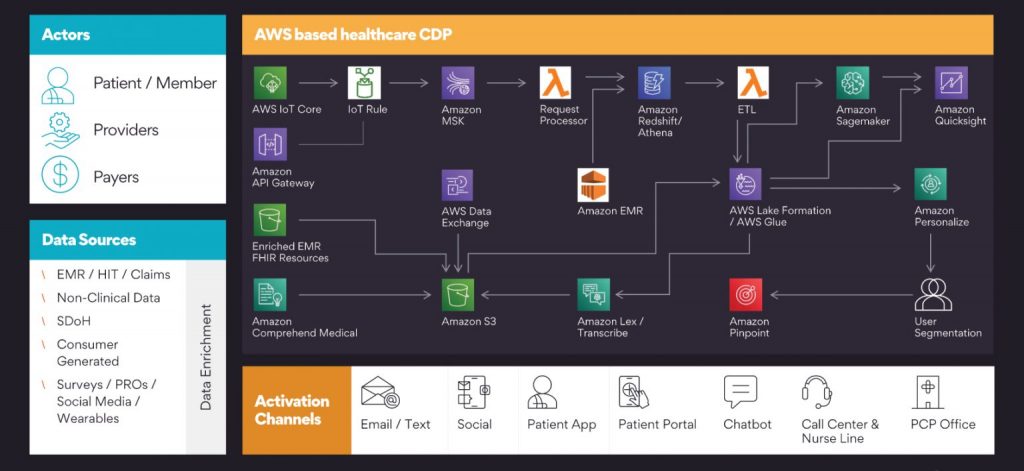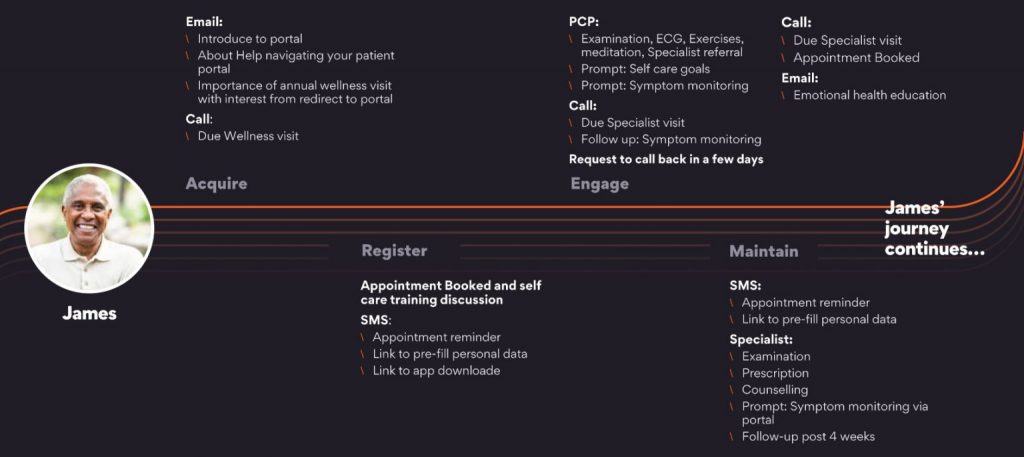It is the need of the hour to drive personalization to have a better understanding of our patient behavior and needs. In this blog, we will continue (Part 1) to talk about how to tackle design and operate a data-driven; multi-channel engagement platform using AWS.
Customer Data Platform for Healthcare Customer Data Platform (CDP), powered by AWS can empower providers with the ability to make highly personalized patient engagements possible, all while navigating complex regulations and addressing high consumer attrition. The next gen data-driven marketing for Healthcare Providers.
AWS based architecture:

The above image shows a high-level overview of the components and services that make up the Personalized Patient Engagement Solution (PPE)
Different stakeholders, mainly patients, payers and providers, can use several optimized channels in this solution, such as email/SMS, mobile apps, wearables, chatbots et. for personalized patient interventions.
PPE uses the following AWS services:
- Amazon Cognito provides security, identity and compliance. It uses web-identity federation authentication to grant access to the patient-facing systems using familiar methods like a patient’s social media credentials.
- Patient symptoms and medical notes are analyzed and tagged for automated decision-making by Amazon Comprehend Medical.
- AWS IoT Core provides the backbone for ingesting, processing, and analyzing medical device and wearable data.
- AWS Data Exchange enables you to find, subscribe to, and use third-party data sets. All the third party data sets related to patient surveys, PROs, SDoH, social media sentiments, etc. can be routed through the data exchange service.
- Amazon Kinesis Data Streams is a scalable and durable real-time streaming service and supports an extended microservices architecture while decoupling the system. It also provides event-driven messaging.
- First-party patient data extracted primarily from EMR, attributes, transactions, and session state are encrypted at-rest and managed in the high-performance and scalable Amazon DynamoDB NoSQL datastore.
- AWS Glue, along with crawlers, is used to fully manage ETL (extract, transform, and load) operations. Diverse data sources such as EHR, wearables, social media et. are analyzed and classified based on predefined rules. It also helps in automatically inferring database and table schemas from the data in Amazon S3 and storing the associated metadata in the AWS Glue Data Catalog.
- Raw and curated data generated through all channels is ingested into the AWS Lake Formation data lake for further processing and analytics.
- Amazon SageMaker ML models feed on the data from the Lake formation and external datasets to find causation and correlation in it. The models train on historical patient data plus patient response and thus learn more about the patient continuously.
- Amazon Personalize trained model is executed against any new patient insights in real-time to place patients in a more appropriate segment in real-time. After a patient is segmented into one or more groups, Amazon Pinpoint engages patients with relevant content on their preferred channel.
- Amazon Quicksight enables the analysis and visualization of data across the solution. It can also be used to configure and monitor key KPIs.
- Other services, such as the AWS Lambda function, send notifications to subscribers via an API.
Here is a use-case with James to reduce the care gap and increase self-care levels.

As depicted, we are following the journey of James, a representative patient. The following are his health details:
Age:55
- Suffering from congestive heart failure
- No Primary Care Physician (PCP) visit in the last one year
- Current segment: Uninformed Chronic Care
- Target segment: Loyal constrained or busy disengaged
Currently, his self-care levels are quite low. The system classifies him in a segment that suits his behaviors and clinical needs and starts recommending interventions. It has also set up target healthier segments for him by factoring in his top barriers and facilitators in accordance with the COM-B model.
There are theoretically numerous paths that James can take during this transition. The solution, powered by a supervised ML algorithm, determines the most optimal path. As James responds to these interventions, the system learns more about him and his journey gets even more personalized. Highlighted in the image at each stage of the journey are dynamic, personalized recommendations set up by the system for James.
Solution Umbrella: Repurposing the same core platform to serve plethora of HCOs
The use case discussed above will help a provider reduce the care gap for their patients. This means healthier outcomes for the patients and improved retention and lifetime value for the provider. How about other sub segments say a specialty provider serving chronic kidney patients or a CRO running immuno-oncology trials. Their needs from a personalized patient engagement solution will shift significantly. It’s true for their patients as well.
These variations in needs have been duly considered during solution design. Same core components with minor modifications can be repurposed to enable diverse use cases fulfilling the needs of tertiary and specialty providers. Apart from that the solution also helps Payers and CROs to keep their patients engaged with personalized interventions.
This is supported by the following use cases that we have been able to realize:
Improved patient adherence – Applicable to CROs that primarily deal with decentralized clinical trials
The following are other use cases applicable to providers and payers:
- Preventive wellness
- Automated appointment reminders, wellness campaigns, immunizations, screening alerts
- Personalized email campaign, follow-up, contextual bot interactions
- Identified and segmented patients or members with high, medium or low call volumes to serve them better
- Non-emergency care ER patient visits are avoided by diverting to telemedicine or urgent care
- Connected call center experiences for efficient care delivery
- Identified super utilizers for healthier outcomes
- HEDIS: Integrated clinical data with CRM, allowable adjustments, licensing & certification, digital measures, ECDS reporting etc.
Key differentiators:
Some of the salient features that set our solution apart:
- Personalized recommendation driven by Intent (Patient-Provider touchpoints), Social Determinants of Health (SDoH), clinical and claims data to deliver interventions based on personal needs, & behaviors
- Patient Engagement Framework build on behavioral sciences model to enable cross functional clinical and non-clinical solutions for current and future business needs
- Dynamic templates for each patient to identify ‘Next Best Action’ based on prescriptive and predictive analytics
- Adaptive – Real-time continuous assessing and quantifying the efficacy of each intervention to deliver better patient experience
Healthcare is shifting to a more enhanced patient centric ecosystem. Reimagine your patient engagement with the 5-step approach to personalization.
Contact our experts for a 1:1 demo on how your organization can leverage patient personalization to collect and unify disparate patient data, gather intelligent, actionable, and trusted insights to deliver efficient and personalized care delivery. Read more about AWS Healthcare and Life Sciences Competency.






